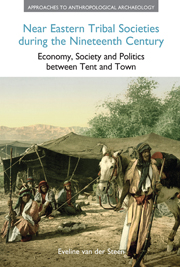 Near Eastern Tribal Societies during the Nineteenth Century
Near Eastern Tribal Societies during the Nineteenth Century Book contents
- Frontmatter
- Dedication
- Contents
- Acknowledgements
- Introduction
- 1 What is a tribe?
- 2 Travellers in the Levant during the nineteenth century
- 3 The dynamics of territorial and power structures
- 4 Oral traditions
- 5 Tribal society and its relation to the landscape
- 6 Tribal institutions
- 7 Relations between the tribes and the state
- 8 From tribe to tribal state: three case studies
- 9 The economy of tribal societies
- 10 Ethnicity and the sense of belonging
- 11 Women in tribal societies
- 12 Religion and folklore
- 13 Back in time: historical parallels
- Notes
- References
- Index
10 - Ethnicity and the sense of belonging
- Frontmatter
- Dedication
- Contents
- Acknowledgements
- Introduction
- 1 What is a tribe?
- 2 Travellers in the Levant during the nineteenth century
- 3 The dynamics of territorial and power structures
- 4 Oral traditions
- 5 Tribal society and its relation to the landscape
- 6 Tribal institutions
- 7 Relations between the tribes and the state
- 8 From tribe to tribal state: three case studies
- 9 The economy of tribal societies
- 10 Ethnicity and the sense of belonging
- 11 Women in tribal societies
- 12 Religion and folklore
- 13 Back in time: historical parallels
- Notes
- References
- Index
Summary
We must have Blood, you know. Some young fellows, you know, may be a little behind their station, perhaps, in point of education and behaviour, and may go a little wrong, you know, and get themselves and other people into a variety of fixes – and all that – but deuce take it, it's delightful to reflect that they've got Blood in ‘em! Myself, I'd rather at any time be knocked down by a man who had got Blood in him, than I'd be picked up by a man who hadn't!
(Charles Dickens, David Copperfield)Introduction
The meaning of the word “ethnic” has changed substantially over time. During the nineteenth century, the science of ethnology referred to the concept of “race”. It was not until the 1950s that a group of internationally renowned sociologists signed a statement officially replacing the word “race” with “ethnic group”. During the nineteenth century, ethnic groups, or races, were seen as natural and unchanging, groups in which the members shared inherited traits. Each group had its place in the world order. Polygenists claimed different “races” had different origins, and therefore their place in the world order was hard and fast, assigned to them by their inheritance.
In 1925 Max Weber (in Wirtschaft und Gesellschaft) stated that ethnic groups are artificial constructs, created and maintained by a shared belief in common origins. Fredrik Barth (Ethnic Groups and Boundaries, 1969) pointed out that these beliefs and the way in which they create and maintain ethnic groups are continually renegotiated and reformulated to accommodate the changing environment or, rather, a changing population because a group's “ethnicity” (or any form of group identification) is only relevant in the confrontation or interaction with other groups.
- Type
- Chapter
- Information
- Near Eastern Tribal Societies during the Nineteenth CenturyEconomy, Society and Politics between Tent and Town, pp. 191 - 215Publisher: Acumen PublishingPrint publication year: 2013


